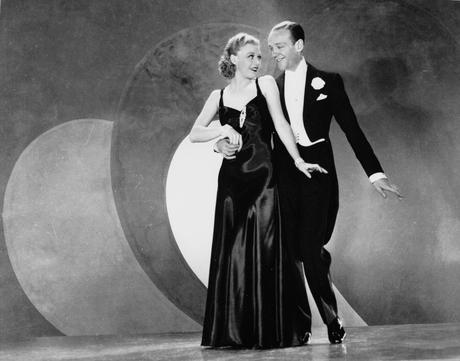
When you look at the list of stars who were labeled Box Office Poison by the Independent Theater Owners Association (ITOA) in 1938 through a contemporary lens, it’s easy to be surprised that most of them would ever be called anything of the sort. Over 80 years have passed since that ad was published and the majority of the stars included in it are now regarded as some of the biggest icons of 1930s Hollywood. Fred Astaire is a prime example of this. Not only does his name remain synonymous with the entire genre of movie musicals, when you look at all the movies he appeared in during the 1930s alone, the list is rather impressive. It includes nine out of ten movies he made with Ginger Rogers and when you look even closer, you see that he went from supporting player to leading man in the span of a couple of years. So what happened?
In my article about Dolores del Rio, I talked a bit about how the chemistry between Fred Astaire and Ginger Rogers stole some of the attention away from Dolores in 1933’s Flying Down to Rio. Even though she was the top-billed star of the movie, it’s now best remembered for being the first time Astaire and Rogers appeared together in a movie. It was also only the second film Astaire had ever appeared in, the first being 1933’s Dancing Lady.
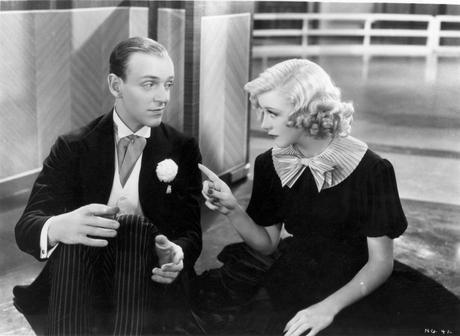
After seeing the reaction to Astaire and Rogers in Flying Down to Rio, RKO was eager to pair them up again in 1934’s The Gay Divorcee, which was a commercial hit and earned a Best Picture Oscar nomination. The duo’s successful streak continued with 1935’s Roberta, which was followed up by the trifecta of Top Hat, Follow the Fleet, and Swing Time.
Being able to say you starred in Top Hat, Follow the Fleet, and Swing Time all in a row is extremely impressive, but a run of movies like that is a very tough act to follow. Top Hat was RKO’s most successful movie of the entire 1930s and Follow the Fleet and Swing Time were both highly successful as well. But Shall We Dance saw a notable decline in box office returns compared to Follow the Fleet and Swing Time.
When Shall We Dance was released in May 1937, early expectations were high and early buzz was favorable. For example, here’s an ad that ran in the May 5, 1937 issue of Variety:
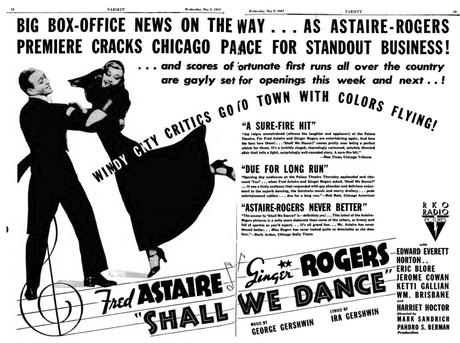
This ad features quotes from Chicago-based publications and included remarks like:
“This latest of the Astaire-Rogers pictures is a mite more elaborate than some of the others, as breezy and full of sparkle as you’d expect…It’s all grand fun.”
“‘Shall We Dance’ comes pretty near being a perfect vehicle for them.”
“…It was a lively audience that responded with gay abandon and delicious enjoyment to superb dancing, the Gershwin music and merry drollery…peak entertainment calibre…due for a long run.”
In their own review of Shall We Dance, Variety wrote, “There have been others in the string which have had stronger tunes, superior punch laughs, and packed more dynamite in Astaire’s own specialties, yet seldom have these ingredients been made to fit so evenly. All six songs [by George and Ira Gershwin], one more than usual, have been nicely spotted with no attempt to overplay any of them. Nor is there a bad ditty in the batch.” Variety also favorably noted the quality of the script and the comedy.
By the time the May 12, 1937 issue of Variety was published, that early hype had faded fast and there was a distinct change in tone about Shall We Dance. While some theaters reported that Shall We Dance doing well at their location, several others said the response was underwhelming compared to other Astaire-Rogers vehicles. When you have blockbusters like Top Hat and Follow the Fleet in your recent career history, it’s got to be disappointing to see the release of one of your movies discussed about under headlines like, “No Flops, No Hits in Wash.”
Despite the sub-par box office returns for Shall We Dance, it didn’t lose money in the long run. However, its profits were just a fraction of what was expected. As successful the Astaire and Rogers partnership had been, by this time, they both agreed that it was time to change things up. Between 1933 and 1937, they had made seven movies together and the underwhelming box office returns for Shall We Dance suggested that perhaps the public needed a break, too.
When actors worry about getting typecast, it’s usually about being known for only playing one type of role. But in Fred’s case, he was more concerned about being pigeon-holed for being half of a duo. In his days as a stage performer before coming to Hollywood, he had been known for performing with his sister, Adele, and they didn’t stop performing together until 1932. So given that he made Flying Down to Rio in 1933, he hadn’t really had much of a chance to establish a professional identity that wasn’t tied to someone else.
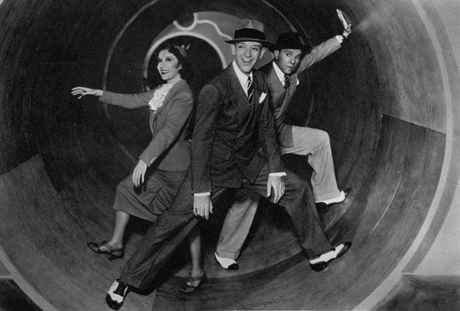
Fred’s next film, 1937’s A Damsel in Distress, gave him a break from Ginger and starred him alongside George Burns, Gracie Allen, and Joan Fontaine instead. Joan Fontaine was still just an up-and-coming star at the time, but the combined star power of Fred Astaire and Burns and Allen wasn’t enough to carry the picture. It ended up being the first Fred Astaire movie to lose money. Audience responses seem to have been largely indifferent. Looking at comments from theater owners in the February 26 and March 5, 1938 issues of the Motion Picture Herald, they describe a mix of middling-to-poor audience reactions:
“Running time too long for the story. Astaire below former standard. Saved by Burns & Allen. Dancing secondary. Story poor.”
“While this picture did not do ‘Follow the Fleet’ or ‘Top Hat’ grosses, we had no walkouts, no complaints. Picture contains an abundance of laughs, and contrary to previous reports, our patrons did not feel that Gracie and George were overdone. Fred’s Drum Dance is in a class by itself. Of course, Ginger Rogers was missed in this production, but our patrons had the pleasure of seeing her the night before in ‘Stage Door.'”
“A fairly good musical that starved to death at the box office. Grossed about half the usual ‘take’ on the team of Astaire and Rogers. In spite of the valiant efforts of Burns and Allen, the picture was dull in spots and many patrons were frank to say they did not care for it. RKO should either give us the team of Astaire and Rogers or reduce our allocation.”
“This has always been an Astaire town, but they did not come out for ‘Damsel’ and those who did were not enthusiastic. Would say that a poor title, radio stars in support, Ginger Rogers lacking, and Fred himself mechanical were causes. The ‘drum dance’ was an example of the lack of spontaneity. To us, it lacked ‘it.'”
“Not half the show you were led to believe from studio publicity. Without Burns & Allen, it would have been very poor indeed. With all his dancing ability, Fred Astaire cannot carry a picture alone. Pulled only fairly well and pleased to just about the same degree.”
The less-than-enthusiastic response to A Damsel in Distress wasn’t a surprise to Fred. In his autobiography, he called it “a goodish picture” that accomplished what it was supposed to, but also acknowledged that it wasn’t a strong movie and that some of his fans were bound to be disappointed by not seeing him with Ginger.
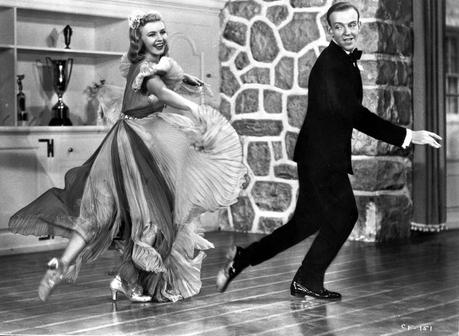 Carefree.<\/em>","created_timestamp":"0","copyright":"","focal_length":"0","iso":"0","shutter_speed":"0","title":"gettyimages-2637842","orientation":"0"}" data-medium-file="https://hollywoodrevue.files.wordpress.com/2021/01/fred-astaire-ginger-rogers-carefree.jpg?w=300" data-permalink="https://hollywoodrevue.wordpress.com/gettyimages-2637842/" alt="Fred Astaire and Ginger Rogers in Carefree." srcset="https://hollywoodrevue.files.wordpress.com/2021/01/fred-astaire-ginger-rogers-carefree.jpg 800w, https://hollywoodrevue.files.wordpress.com/2021/01/fred-astaire-ginger-rogers-carefree.jpg?w=150 150w, https://hollywoodrevue.files.wordpress.com/2021/01/fred-astaire-ginger-rogers-carefree.jpg?w=300 300w, https://hollywoodrevue.files.wordpress.com/2021/01/fred-astaire-ginger-rogers-carefree.jpg?w=768 768w" class="wp-image-11166" data-large-file="https://hollywoodrevue.files.wordpress.com/2021/01/fred-astaire-ginger-rogers-carefree.jpg?w=620" />
Carefree.<\/em>","created_timestamp":"0","copyright":"","focal_length":"0","iso":"0","shutter_speed":"0","title":"gettyimages-2637842","orientation":"0"}" data-medium-file="https://hollywoodrevue.files.wordpress.com/2021/01/fred-astaire-ginger-rogers-carefree.jpg?w=300" data-permalink="https://hollywoodrevue.wordpress.com/gettyimages-2637842/" alt="Fred Astaire and Ginger Rogers in Carefree." srcset="https://hollywoodrevue.files.wordpress.com/2021/01/fred-astaire-ginger-rogers-carefree.jpg 800w, https://hollywoodrevue.files.wordpress.com/2021/01/fred-astaire-ginger-rogers-carefree.jpg?w=150 150w, https://hollywoodrevue.files.wordpress.com/2021/01/fred-astaire-ginger-rogers-carefree.jpg?w=300 300w, https://hollywoodrevue.files.wordpress.com/2021/01/fred-astaire-ginger-rogers-carefree.jpg?w=768 768w" class="wp-image-11166" data-large-file="https://hollywoodrevue.files.wordpress.com/2021/01/fred-astaire-ginger-rogers-carefree.jpg?w=620" />By the time the Box Office Poison commotion got started in 1938, Fred was busy working on Carefree, bringing him back together with Ginger Rogers. In response to being named Box Office Poison, Fred seems to have largely taken it in stride. When he wrote about it in his memoir, his response is remarkably restrained. He simply wrote, “The incident bothered me, of course. In fact, it burned me up. [His wife] Phyllis dismissed the whole thing with, ‘Oh, stop worrying about it.’ And I did.” He also noted that RKO was angry enough to consider demanding a retraction, but decided to just let it be and give it time to die out on its own. RKO’s response seems plausible since, in his case, the Box Office Poison label seems to have been based on a single movie that lost money and another that merely earned less than expected.
While he let the Box Office Poison label roll off his back, movie stardom was starting to loose a bit of its luster for Fred at this point. After Damsel in Distress, he had been toying with the idea of retiring and stated this in his autobiography:
“Frankly, I was a bit fed up at the thought of fighting my way back to a movie status again. Not that I was considered through or anything of the sort, but it so happens that when you go through a lull like that, the general feeling is that you’re going to lull yourself right through the cellar floor. I was a bit worried because with a dancing career such as mine, highly specialized as it was, I couldn’t figure out for sure where I would be able to go. I would have liked to go straight dramatic, but that was not possible. I felt I wasn’t qualified to do it.”
While Carefree was in production, The Story of Vernon and Irene Castle was already lined up for Fred and Ginger and there was a lot of buzz about it being planned as their final on-screen pairing. At this point, Fred wasn’t exactly sure where his career was headed, but knew a change would be good. While Ginger was getting ready to branch out into more dramatic, non-musical roles, he was talking to other studios and weighing his options. In the meantime, making Carefree was a very enjoyable experience for him. It gave him a chance to do a golf-inspired number that he’d been wanting to do, he was quite fond of the “Change Partners” number, and he had a lot of fun with “The Yam” number. Unfortunately, it ended up being the first Astaire-Rogers movie to lose money. 1939’s Story of Vernon and Irene Castle was well received and did well at the box office, but high production costs meant that it wasn’t able to break even.

After wrapping up work on Vernon and Irene Castle, he took a bit of a break from Hollywood and later returned as a freelance actor. The 1940s ended up being a very memorable decade for Fred’s career and he was able to work with a lot of first-rate talent at various studios. During this time, he appeared in movies like Broadway Melody of 1940 with Eleanor Powell, Holiday Inn with Bing Crosby, You’ll Never Get Rich and You Were Never Lovelier with Rita Hayworth, and Ziegfeld Follies with Gene Kelly.
After 1946’s Blue Skies, he announced his retirement, but that retirement ended up being nothing more than a brief break. His career reached another high point with movies like 1948’s Easter Parade with Judy Garland, 1951’s Royal Wedding with Jane Powell, and of course, 1949’s The Barkleys of Broadway, which teamed him up with Ginger Rogers one last time.
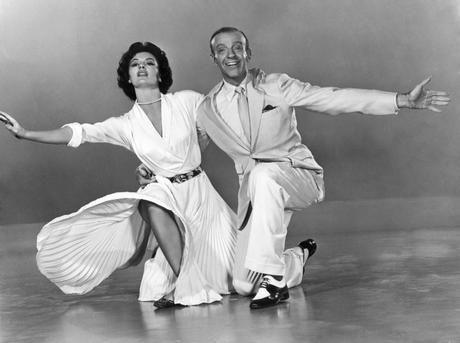
As he headed into the 1950s, he continued to find success. 1953’s The Band Wagon is often regarded as being one of the all-time best of the musical genre, often referenced today as being on the same level as Singin’ in the Rain. As the 1950s wore on, he made a few more notable musicals like Silk Stockings and Funny Face, but started doing more television projects. He also finally got to do some non-musical movies, like 1959’s On the Beach, which he earned a Golden Globe nomination for, and 1974’s The Towering Inferno. His last acting role was 1981’s Ghost Story, but of course, he also appeared as himself in the first two That’s Entertainment! movies.
